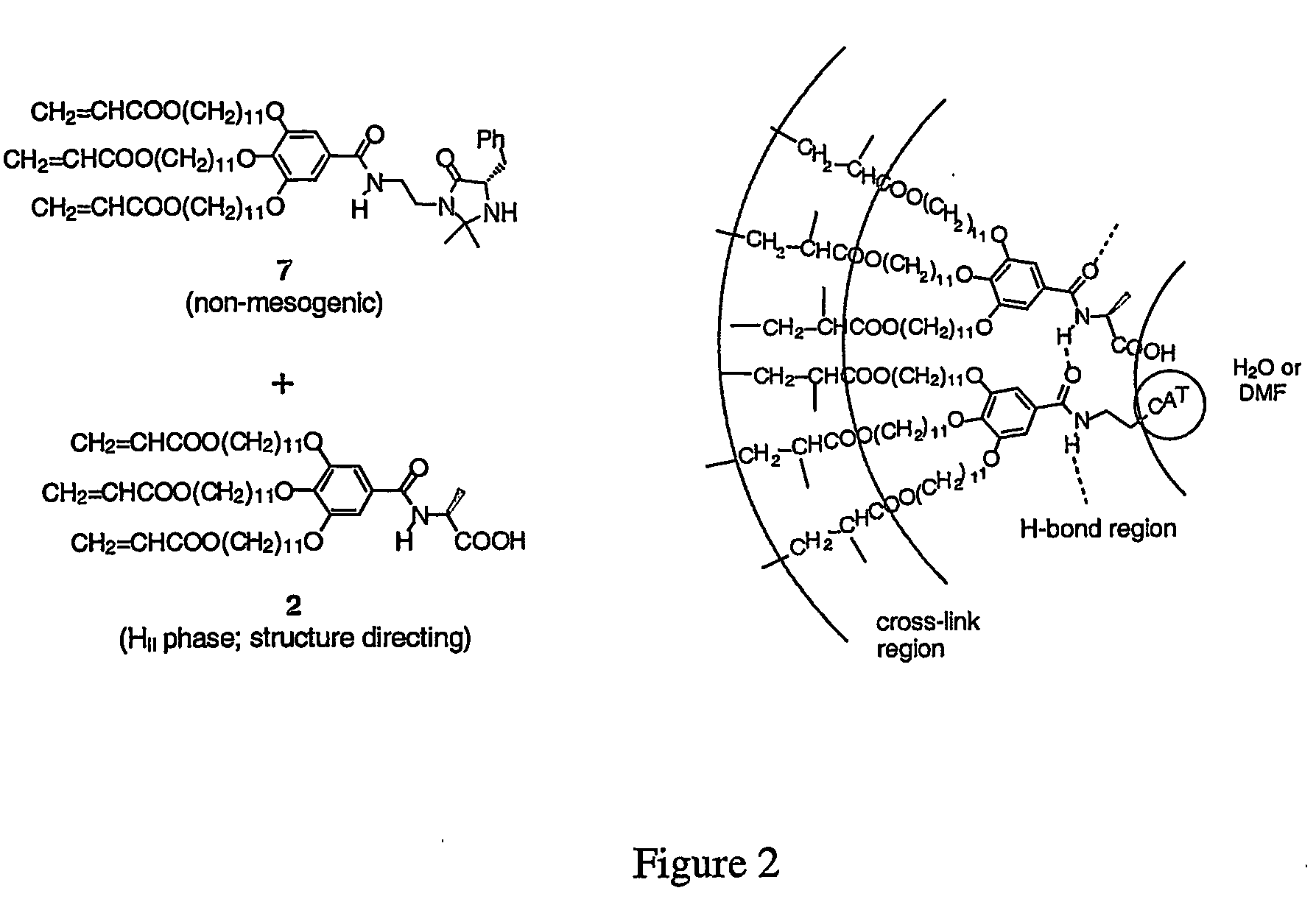Functionalized nanostructured lyotropic liquid crystal polymers
a liquid crystal polymer and functional technology, applied in the field of lyotropic liquid crystal polymers, can solve the problems of poor tunability and processibility, processing alignment problems, etc., and achieve the effect of broadening the scope and utility of solid-state polymer materials
- Summary
- Abstract
- Description
- Claims
- Application Information
AI Technical Summary
Benefits of technology
Problems solved by technology
Method used
Image
Examples
example 1
Preparation of Compounds 1 and 2
[0062] Materials and General Procedures. Methyl gallate, 11-bromoundecanol, acryloyl chloride, 2-hydroxy-2-methyl propiophenone, L-alanine, β-alanine, L-phenylalanine, S-lactic acid, and 2-aminoethanesulfonic acid were obtained from the Aldrich Chemical Co. and used as purchased. Thionyl chloride (Aldrich) was distilled prior to use. Methylene chloride was vacuum-transferred from CaH2 prior to use. THF (Fisher) was vacuum-transferred from sodium benzophenone ketyl and degassed via repeated freeze-pump-thaw cycles before use. All other chemicals and solvents were purchased from either Aldrich or Fisher Scientific and used without further purification unless otherwise indicated. Normal phase column chromatography was performed using 230400 mesh silica gel purchased from EM science. C18-reverse phase silica gel (230-400 mesh) and C18-reverse phase nano-silica gel TLC plates were purchased from Fluka. Acidic ion-exchange resin AG 50W-X8 (100-200 mesh, hy...
example 2
Preparation of an LLC Mixture of Compound 1 and Compound 2
[0067] General procedure for preparation of LLC mixtures. LLC mixtures were prepared as follows: Appropriate amounts of the amphiphile(s) and DMF or water based on weight were combined in a small test tube and mixed with a spatula until the mixture was homogeneous to the eye. After wrapping in Parafilm™, the tube was immersed in a hot water bath (˜100° C.) for 10 s to melt and thermally mix the samples. Hand-mixing with a spatula was continued for another 2 minutes, followed by a centrifugation at 3800 rpm for 15 min. The sample tube was sealed with Parafilm™ during centrifugation to prevent evaporative loss of the solvent. This procedure was repeated three times, or until the mixture appeared homogeneous under the PLM. Homogeneous mixing was characterized by a lack of any crystalline regions, and the appearance of a blue hue in the PLM optical texture. The birefringent mixtures were then analyzed by XRD to confirm the natur...
example 3
Catalysis Results for LLC Mixture of Compound 1 and Compound 2
[0071] Heterogeneous acid catalysis experiments were performed using the esterification of benzyl alcohol with 1-hexanoic acid in dry toluene as a test platform (FIG. 7). We demonstrated that the nanostructured LC acid resin (5:1 (mol / mol) 1:2 in powdered form) (prepared as described in Example 2) has slightly higher reactivity than commercial Amberlyst™-15 (Rohm Haas) and Nafion® NR50 (DuPont) of approximately the same particle size at a loading level of 5 mol % acid sites (FIG. 8). More importantly, it was found that the nanostructured acid resin exhibits much higher selectivity for the desired ester product over unwanted side products such as dibenzyl ether. FIGS. 9A and 9B show representative gas chromatographs of the product mixture from an esterification reactions using Amberlyst™-15 (9A) and the nanostructured LC acid resin (9B), respectively. The products were identified by GC-MS. As can be seen in the plots in F...
PUM
| Property | Measurement | Unit |
|---|---|---|
| Ratio | aaaaa | aaaaa |
| Acidity | aaaaa | aaaaa |
Abstract
Description
Claims
Application Information
 Login to View More
Login to View More - R&D
- Intellectual Property
- Life Sciences
- Materials
- Tech Scout
- Unparalleled Data Quality
- Higher Quality Content
- 60% Fewer Hallucinations
Browse by: Latest US Patents, China's latest patents, Technical Efficacy Thesaurus, Application Domain, Technology Topic, Popular Technical Reports.
© 2025 PatSnap. All rights reserved.Legal|Privacy policy|Modern Slavery Act Transparency Statement|Sitemap|About US| Contact US: help@patsnap.com



